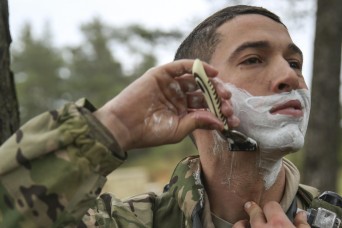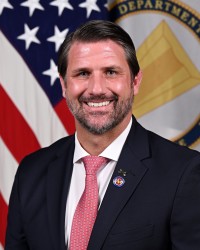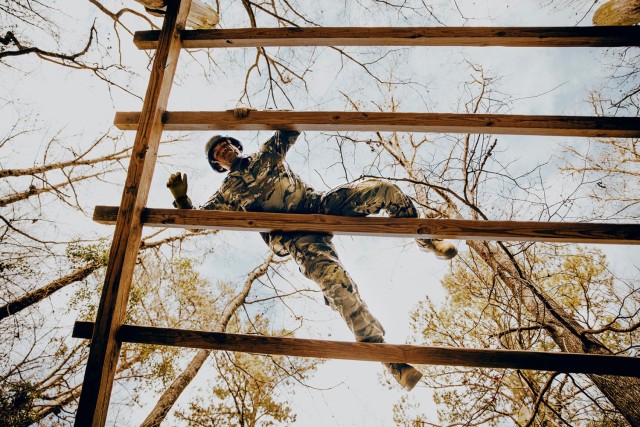News
-
 Army updates facial hair policy to reinforce grooming standards
July 8, 2025
Army updates facial hair policy to reinforce grooming standards
July 8, 2025
-
 Army scales down Military Working Equid program for warfighting priorities
July 2, 2025
Army scales down Military Working Equid program for warfighting priorities
July 2, 2025
-
 Fort Carson to observe Child Abuse Prevention Month
March 6, 2025
Fort Carson to observe Child Abuse Prevention Month
March 6, 2025
-
 Army honors military children by Purpling Up
April 1, 2025
Army honors military children by Purpling Up
April 1, 2025
-
 PCSing? Help available when searching for that next home
May 5, 2022
PCSing? Help available when searching for that next home
May 5, 2022
-
 75th FA BDE establishes Reception Platoon
November 14, 2025
75th FA BDE establishes Reception Platoon
November 14, 2025
-
 Nashville District invests in tomorrow’s leaders through leadership program
September 9, 2025
Nashville District invests in tomorrow’s leaders through leadership program
September 9, 2025
-
 The Power of Partnership: Turning Challenges into Capabilities - U.S. Army Aberdeen Test Center Perryman Wash Rack
August 28, 2025
The Power of Partnership: Turning Challenges into Capabilities - U.S. Army Aberdeen Test Center Perryman Wash Rack
August 28, 2025
-
 A DIGITAL DIVE
August 25, 2025
A DIGITAL DIVE
August 25, 2025
-
 THE ART OF ACQUISITION
August 25, 2025
THE ART OF ACQUISITION
August 25, 2025
-
 BE HONEST AND HUMBLE
August 25, 2025
BE HONEST AND HUMBLE
August 25, 2025
-
 Kentucky Guard, Djibouti Military Partner on Cyber, Radio Exchange
July 24, 2025
Kentucky Guard, Djibouti Military Partner on Cyber, Radio Exchange
July 24, 2025
-
 Massachusetts Guard Hosts Regional Cooperation Exercise
June 26, 2025
Massachusetts Guard Hosts Regional Cooperation Exercise
June 26, 2025
-
 Sec Army, DASA-IHP visit focuses on readiness, infrastructure at Fort Stewart-HAAF
June 25, 2025
Sec Army, DASA-IHP visit focuses on readiness, infrastructure at Fort Stewart-HAAF
June 25, 2025
-
 Washington Guard, Malaysia Armed Forces strengthen ties at Bersama Warrior 2025
June 18, 2025
Washington Guard, Malaysia Armed Forces strengthen ties at Bersama Warrior 2025
June 18, 2025
-
 Secretary of the Army Visits Redstone Arsenal, Reaffirms Push for Faster, Smarter Military Tech
June 16, 2025
Secretary of the Army Visits Redstone Arsenal, Reaffirms Push for Faster, Smarter Military Tech
June 16, 2025
-
 Maryland Guard, Croatia Support Immediate Response 25
June 13, 2025
Maryland Guard, Croatia Support Immediate Response 25
June 13, 2025
Army Civilian Careers Video: Find Your Next Level
ASA (M&RA) Photo Gallery
-
FROM THE ASA'S DESK
Coming Soon!
ASA PRIORITIES
-
Recruiting/Retention: We strategically adapt the way we recruit and retain talent into the Army in order to sustain the all-volunteer force.
-
Talent Management: We set the successful conditions to acquire, develop, employ, and retain the Soldier and Civilian talent needed to achieve Total Army readiness.
-
Prevention: We develop and reinforce initiatives designed to build positive command climates and reduce harmful behaviors in our Army.
-
-
Readiness: We innovate and seek solutions to put the Army on a sustainable strategic path amidst an era of uncertainty.
ASA (M&RA) Organization Chart
-
army-asamra-org-chart-20250122v1.pdf [PDF - 67.3 KB]
ASA (M&RA) VISION, MISSION, AND GOALS
Vision: Advancing America’s Army with the World’s Greatest Soldiers!
Mission: For the Department of the Army, the Office of the ASA (M&RA) sets strategic direction, develops policy, allocates resources, and supervises all matters pertaining to Manpower and Reserve Component Affairs to sustain and position the Army for the future.
Goals:
1. Talented and Lethal All Volunteer Force. Improve accession, development, retention, and management, while employing the best talent America has to offer.
2. Army Civilian Human Resource Management. Develop in an engaged and committed civilian workforce built on trust, transparency, and relationships.
3. Total Force. Enable the total force to drive readiness and shape the Army of the future.
4. Manpower and Training Resource Allocation. Improve manpower and training resource allocation to optimize the Army’s operational capability to deploy, fight, and win against any adversary.
5. ASA(M&RA) Organizational Improvement. Increase organizational performance through continuous modernization of policies, processes, and systems.
Leaders
-
 Sr. Official Performing the Duties of Assist. Sec. of the Army for Manpower & Reserve Affairs (M&RA)Mr. Derrick M. Anderson
Sr. Official Performing the Duties of Assist. Sec. of the Army for Manpower & Reserve Affairs (M&RA)Mr. Derrick M. Anderson -
 Acting Principal Deputy Assistant Secretary of the Army for Manpower and Reserve Affairs (M&RA)Ms. Julie A. Blanks
Acting Principal Deputy Assistant Secretary of the Army for Manpower and Reserve Affairs (M&RA)Ms. Julie A. Blanks -
 Senior Enlisted Advisor to the Assistant Secretary of the Army for Manpower and Affairs (M&RA)Sgt. Maj. Kenyatta Gaskins
Senior Enlisted Advisor to the Assistant Secretary of the Army for Manpower and Affairs (M&RA)Sgt. Maj. Kenyatta Gaskins
ASA (M&RA) ORGANIZATIONS
- Army Enterprise Marketing Office
- Army G-1
- Army Review Boards Agency
- Civilian Personnel
- Force Management Power and Resources
- Military Personnel & Quality of Life
- People Analytics
- Quality of Life
- U.S. Army Manpower Analysis Agency (USAMAA)
Resources
-
APSC Under Construction.pdf [PDF - 43.1 KB]
-
- DASA-TRM Memo 4 August 2015 - Guidance for Review of the Army FY 2014 Inventory of Contracts for Services (ICS)
- DASA-FMMR Memo 13 November 2014 - Guidance for Justifying Transfers of Workload
- SA Memo 12 September 2014 - Delegation of In-Sourcing Approval Authority
- DASA-FMMR Memo 21 August 2014 - Guidance for Utilization of Military Manpower
- DASA-FMMR Memo 2 May 2014 - Documentation of Contract Man-Year Equivalents(CMEs)
- SA Memo FY2014 Department of the Army Workforce Guidance
- SA Memo 18 December 2013 - Special Duty(Borrowed Military Manpower and Troop Diversion) - Extension of Temporary Suspension and Delegation of Authorities
- DASA-FMMR Memo 14 August 2013 Guidance for Fiscal Year 2012 Inventory of Contract for Services(ISC)
- SA Memo 28 May 2013 In-Sourcing Approval Authority
- DASA-FMMR, DASA(P), DAB Memo 17 April 2013 Guidance for Service Contract Spending Reductions
- SA Memo 11 March 2013 Borrowed Military Manpower Policy
- SA Memo 1 February 2013 Review of the Army Contractor Inventory
- SA Memo 1 February 2013 - SA Review Certification of FY11 ICS
- SA Memo 5 November 2012 - Reservation of In-Sourcing Approval Authority
- DASA-FMMR Memo 20 August 2012 - Request for Services Contract Approval Form Update
- DASA-FMMR Memo 10 August 2012 - Contractor Inventory Review and Certification Requirement
- DASA-FMMR Memo 10 February 2012 - Compliance with Contractor Inventory Policies
- DASA-FMMR Memo 10 February 2012 - Compliance with Contractor Inventory Policies Enclosure
- SA Memo 10 February 2012 - Reservation of Insourcing Approval Authority
- ASA (M&RA) Memo 28 October 2011 - Special Duty - Borrowed Military Manpower Policy
- SA Memo 26 September 2011 - SEC 8108 Army Plan to use CMRA
- DASA-FMMR Memo 12 July 2011 - Generating Force (GF) Review of the Total Army Analysis (TAA) 2014-18 Contractor Man-year Equivalents (CME)
- DASA-FMMR Memo 27 May 2011 - Divestiture Required for Contract Performance of Certain Functions
- DASA-FMMR Memo 22 April 2011 - Prohibition on Converting Certain Functions to Contract Performance
- DASA-FMMR Memo 4 March 2011 - Army In-sourcing Approval Procedures
- SA Memo 1 February 2011 - Reservation of In-sourcing Approval Authority
- SA Memo 9 July 2010 - In-sourcing Policy
- SA Memo 10 July 2009 - Army Policy for Civilian Workforce Management and Service Contracts
- Request for Contract Services Decision Tree
- SA Memo 7 January 2005 - Accounting for Contract Services
ASA M&RA Resources
- Army Human Resources Command
- Army National Guard
- Army Vision and Roadmap to Success
- Army Publishing Directorate
- Army Reserve
- Army Resilience
- Civilian Senior Leader Management Office
- Defense Travel Management Office
- Hire a Soldier Magazine - Issue 2
- Hire a Soldier Magazine - Issue 3
- Hire a Soldier Magazine - Issue 4
- Office of Personnel Management
- Senior Executive Service Information
- Service Contract Requirement Approval
- Senior Enterprise Talent Management (SETM)
- U.S. Army Cadet Command
- U.S. Army Recruiting Command
- U.S. Army Training and Doctrine Command






















